Family : Columbidae

Text © Dr. Gianfranco Colombo

English translation by Mario Beltramini
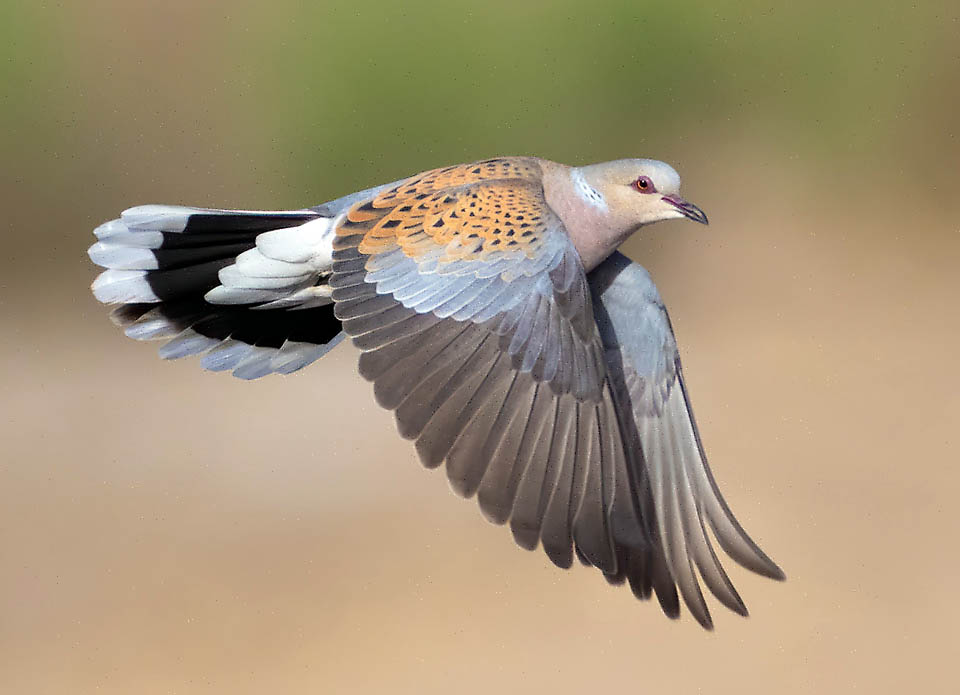
The European Turtle-dove (Streptopelia turtur) is the only European migratory bird belonging to the family of the Columbidae © Anastasiia Merkulova
Poor little European Turtle-dove! Such a sweet and discreet bird and so badly persecuted by humankind! In fact this bird stands along the most hunted in our Palearctic, with hunting campaigns bordering on harassment but even more practically chased by the European hunters themselves up to their winter quarters, where the slaughters occur in even greater numbers. Italy, France, Spain, Malta, Morocco and southwards up to Senegal, excel in this activity but also in the Middle East with Cyprus, Turkey and even more Lebanon and Egypt, the arte of death is incredibly high.
It was thought that the modifications done to the hunting calendars that have predicted opening times postponed after mid-September, would be sufficient to have the migratory flow of this bird already passed and consequently saved but the legislative intrigues of poorly clear laws have allowed many south-Mediterranean regions to advance by a few weeks these deadlines, practically cutting off the escape route to these poor birds.
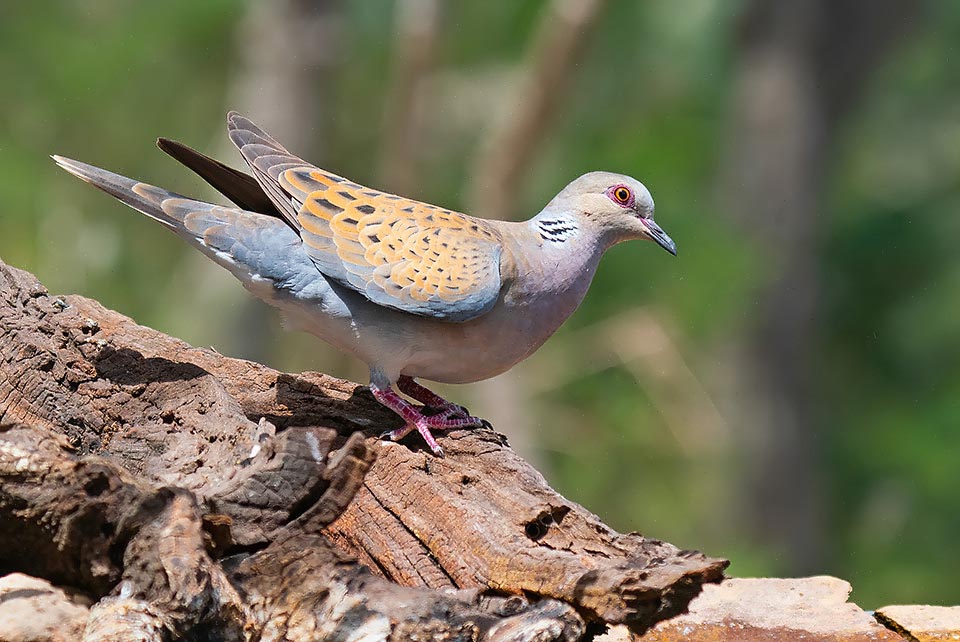
It reaches Eurasia from sub Saharan Africa by late spring but is stationary in some North African regions © Paul Cools
It is not known exactly how many Turtle doves are killed during the autumn migration but surely the number is very close to that corresponding to generations of the young born in the same year. Indeed there is only the hope that during their stay in the African winter quarters no other natural factors do intervene that can reduce even more the number affecting in this case the total size of the populations.
The European Turtle-dove Streptopelia turtur (Linnaeus, 1758), belongs to the order of Columbiformes and to the family of the Columbidae and in Europe is the only migrant belonging to this family.
It is also one of the most beautiful and elegant columbids present on our territory, with a rather coloured livery and a slimmer posture than that of any of its consimilars.
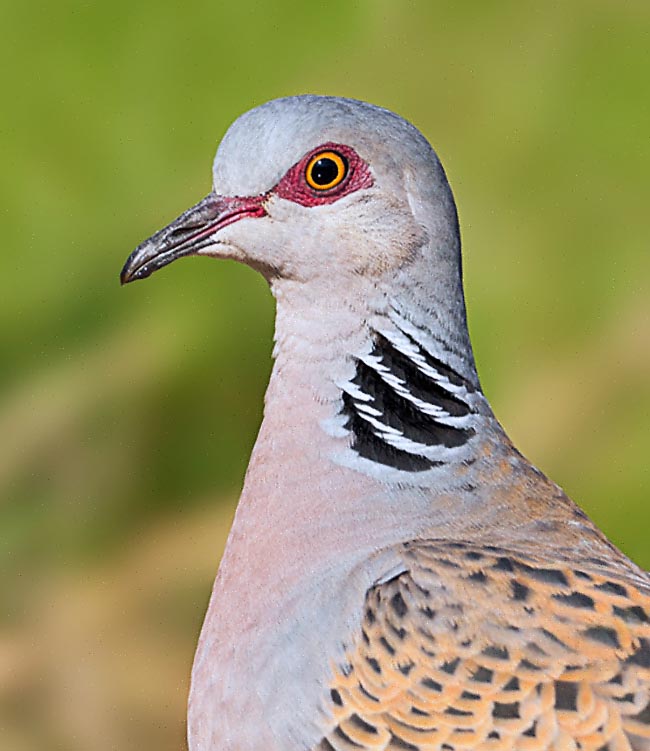
Smaller, slimmer, more elegant than the congeners present in Europe, Streptotelia turtur has pink chest, the eye edged by dark red skin and a characteristic oblique semi-collar with white and black stripes © Ralph Martin
Already pigeons and turtle doves have a morphology with very delicate and balanced shapes, do not have awkward or bulky bodies or beaks, oversized tails or abnormally long legs.
Moreover, they have a very affectionate behaviour greatly appreciated by man, seen that often we use to anthropomorphize their behaviours, adapting them to our way of acting.
It is said to be sweet as a dove, cooing like a dove, the Dove of Peace, we use it as a representation of the Holy Spirit.
The Bible itself reminds that Noah sent a Dove, or Turtledove whatever, to check if the land had re-emerged after the Universal Flood and she came back with an olive branch in its mouth.
Well, this kindness, familiarity and beauty, intrinsic to this family of birds, are well overcome by our wild turtledove.
The etymology of the scientific binomen originates from the genus Streptopelia from the Greek “streptos” and “peleia” dove, hence a dove with the collar whilst the species turtur comes from the Latin term having also the meaning of Dove but of onomatopoeic origin.
In Europe it’s commonly called European turtle-dove in English, Turteltaube in German, Tórtola Europea in Spanish,
Tourterelle des bois in French, Rola comum in Portuguese and Tortora comune or selvatica in Italian.
Zoogeography
The European Turtle-Dove is a Palearctic species and occupies Europe almost totally and proceeding in Asia, an ample belt delimited the north about by the 60th parallel, up to reach Mongolia and southwards by the Central Asian Republics up to include the Middle East.
It is a permanent presence in north-western Africa and occasionally on the Libyan and Egyptian coasts, in the south of Algeria, in all Saharan oases and in the Nile Valley. All Palearctic populations, with partial exception of those residing in Saharan Africa, migrate south of this continent, in the sub-Saharan belt standing from Senegal to the Horn of Africa, limiting to the arid Sahel territory.
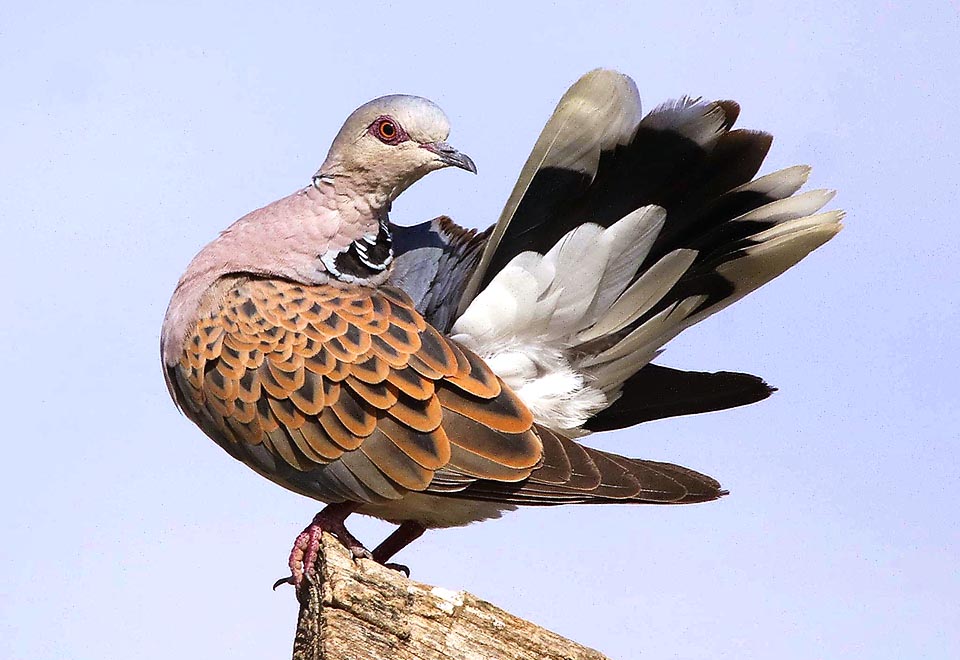
The shoulders have scale-shaped coverts, black with hazelnut brown edge, and reaches the length of 30 cm with a wingspan of about 50 cm © Mourad Harzallah
In Europe is missing north of the Baltic coasts, Scandinavian Peninsula, Finland, Baltic Republics and Denmark. It is present in England but is absent in Scotland and Ireland as well as in Iceland.
The European Turtle-dove is highly migratory and arrives in the nesting quarters in late spring, with extensions until the first ten days of June. It is one of the birds forming the last spring migratory waves.
The autumn return is much earlier and begins as early as July, with a peak in August and an extension always more spaced up to mid September.
However, in the migratory period, especially in the month of August, period of the first autumn weather upheavals in Europe, the stay of the Turtle-dove is rightly conditioned by the weather conditions.
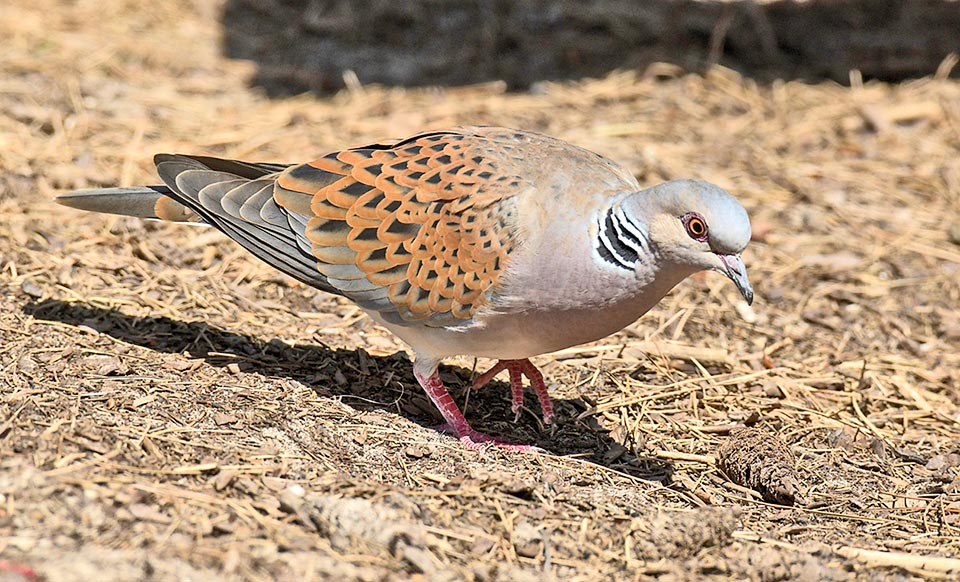
It’s a granivorous bird eating also small fruits like those of the elderberry that help him in storing the fat necessary for the long return flight © didierbas
The hunters know well that the first storms of this month quickly scare these birds away.
In the winter quarters, unlike its usual shy and reserved behaviour the Turtle dove keeps in the nesting areas, it gathers in flocks, huge at times, in particular in the nocturnal gathering places and also in the feeding sites.
Habitat
The genus Streptopelia is typical to the arid zones, to dry environments, at times even pre-desert. Nevertheless in Europe this Turtle-dove has easily adapted to the agriculture, even intensive, for which it is present, numerous, in the cultivated areas, in the fields and in the stubble, in all countries, in the orchards and vineyards and in hilly environments with an altitude not exceeding 500 m.
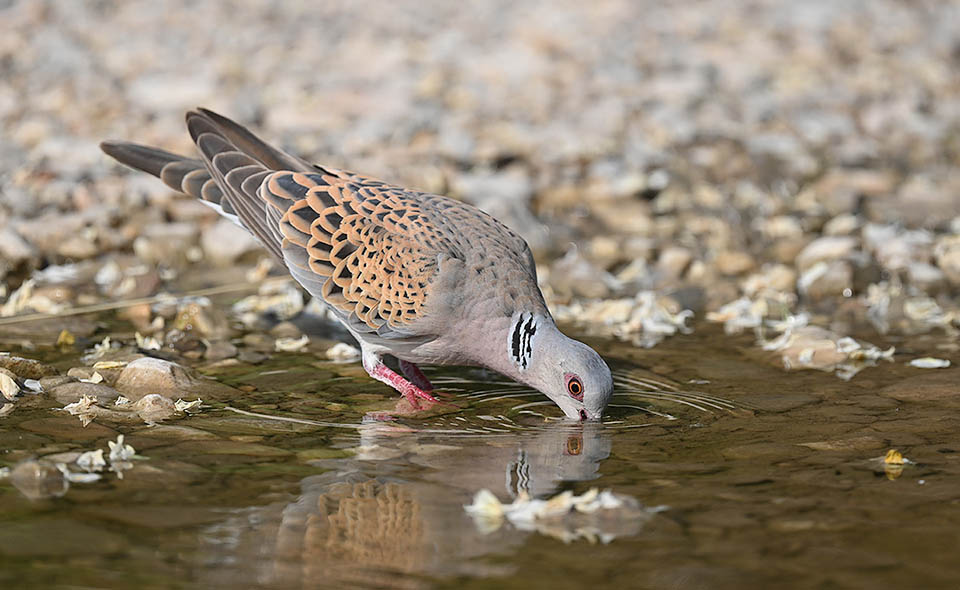
Here quenching its thirst. Even if living in arid sites it cannot help but drink © Gianfranco Colombo
It is a granivorous bird who does not disdain the small ripe fruits.
It loves warm and not humid climates, with a reduced quantity of rain and little wind. Areas even partially woody with high trees where to spend resting, the remainder of the day, riparian banks of watercourses with thick undergrowth of elderberries, of brambles, of low bushes but having in the meantime vast bare areas all around where to graze freely.
The European Turtle-dove loves greatly to keep ambushed in these bushes facing the waterways, during the warm summers, as if it wanted to enjoy the fresh air of the underlying waters but also because these places are the best for nesting.
Moreover, the fruits of the elderberry when ripe, for the European Turtle-dove represent one of the most sought-after delicacies before the migrations, as it helps to store the fat necessary for its long way to Africa.
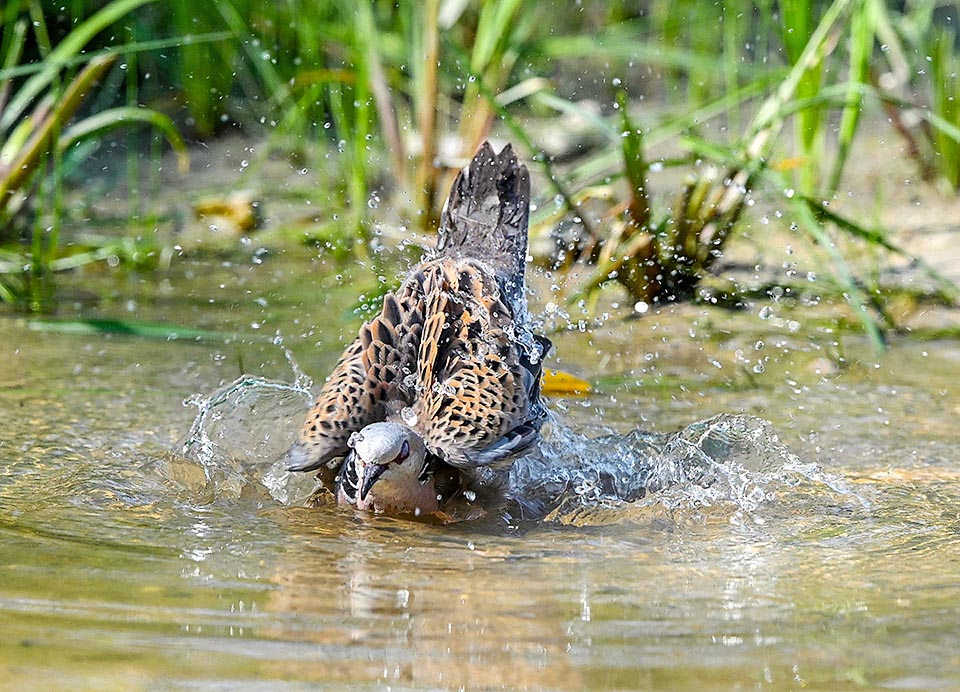
Here takes also advantage for washing and almost always nests not far from the watercourses © Gianfranco Colombo
It loves very much also the seeds of Common fumitory (Fumaria officinalis) also ripening in the same period but also any other essence producing edible seeds like wheat and rapeseed, radish and fennel, buckwheat and cardoon.
Morphophysiology
Streptopelia turtur has a much more pronounced colouring than other turtle doves present in our territories.
Its European congeners limit to the Eurasian collared dove (Streptopelia decaocto) and the Barbary dove (Streptopelia risoria) both with a rather modest livery, with a uniform plumage with the so-called dove-grey colour and with a more or less marked black collar. Consequently, easily distinguishable from the more beautiful wild Turtle dove.
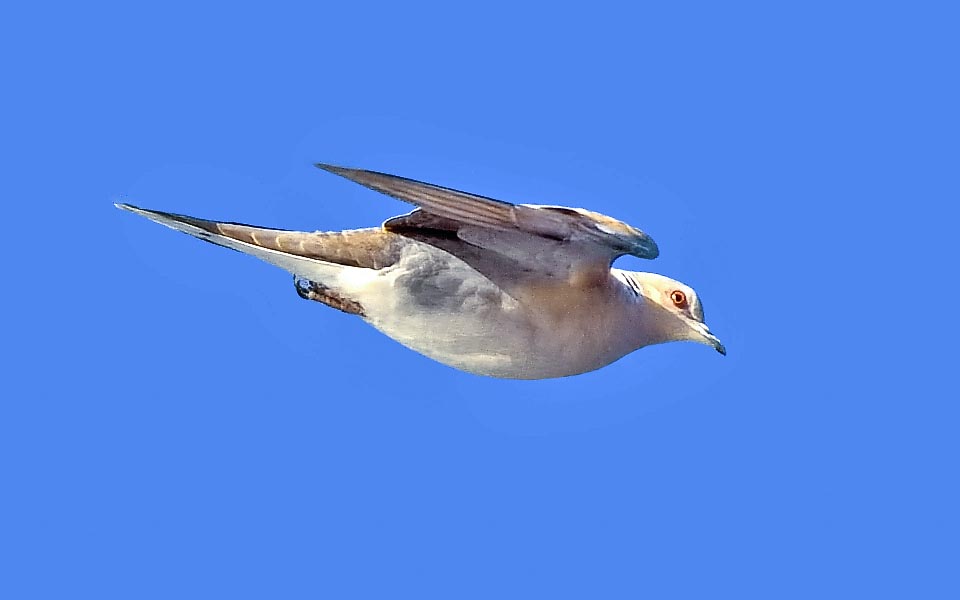
This has just spotted in flight a female and lands attempting to seduce her © Bill Siebert
Moreover, the European Turtle-dove is smaller and slimmer, with much more nervous body movements and with a very fast and lively flight produced by narrower and falcate wings, typical of the migrants.
Hence, its livery is unmistakable when observed in the areas of European nesting.
The colour of the body is uniformly pinkish with the lower parts slightly paler. The shoulders are covered by scale-shaped coverts of different size and of black colour, with a hazelnut brown border quite evident during the reproductive period and depending on the age of the subject.
At the rear, on the neck, stands a semi-collar of fair size, of black colour with white streaks well visible and determinant for the classification of the species on the field.
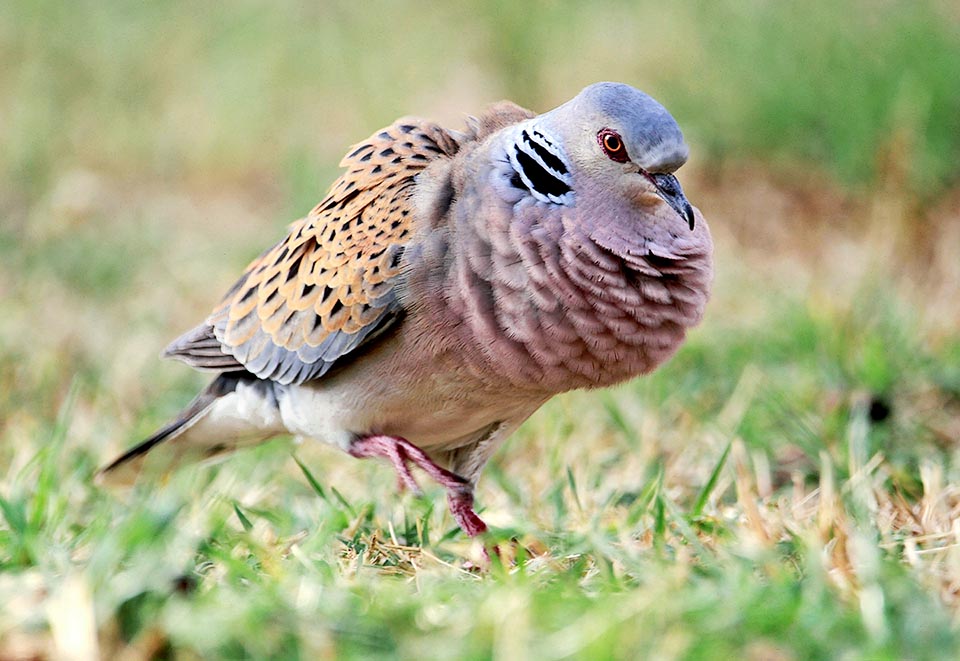
Here swells its chest gurgling in the characteristic wedding parade of the Columbidae © Carlos Figueiredo
The tail, always kept well extended, is blackish with a broad border in the terminal part of the 10 lateral remiges missing, on the contrary, on the two central ones that keep totally black.
The same drawing is re-proposed on the lower face of the tail, in contrast to the pure whiteness of the undertail.
The eyes are surrounded by a border of bare skin dark red in colour like the legs. Conversely, the beak is pearly grey.
There is no distinction between the sexes. Instead, the juveniles are totally greyish and lack all the details present in adults: they will have to wait for the second year moult to assume the same livery.
The European Turtle-dove is about 30 cm long, weighs about 150/200 g and has a wingspan of about 50 cm.
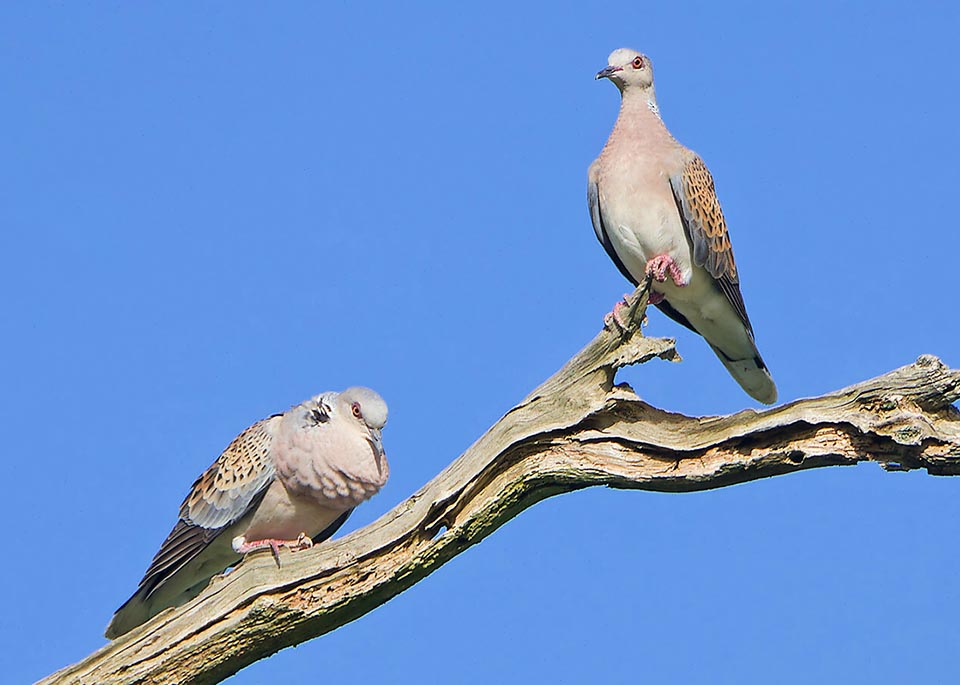
Then continued getting closer also on the branch where the female stays and seems consenting © Blaise Verrier-Cruz
Some subspecies linked mainly to some particular territories have been classified: Streptopelia turtur turtur, the European nominal species, the Streptopelia turtur rufescens typical of the Nile Valley, the Streptopelia turtur hoggara, of the Hoggar and of the south Saharan oases and Streptopelia turtur arenicola of the Asian part.
Ethology and Reproductive Biology
The wild European Turtle-dove has a really and explicitly wild character and contrary to the now ever-present Eurasian collared dove we always find under our feet, does not love to live together in direct contact with the human race.
Even if living in inhabited countryside, it absolutely avoids approaches or proximity to those working there.
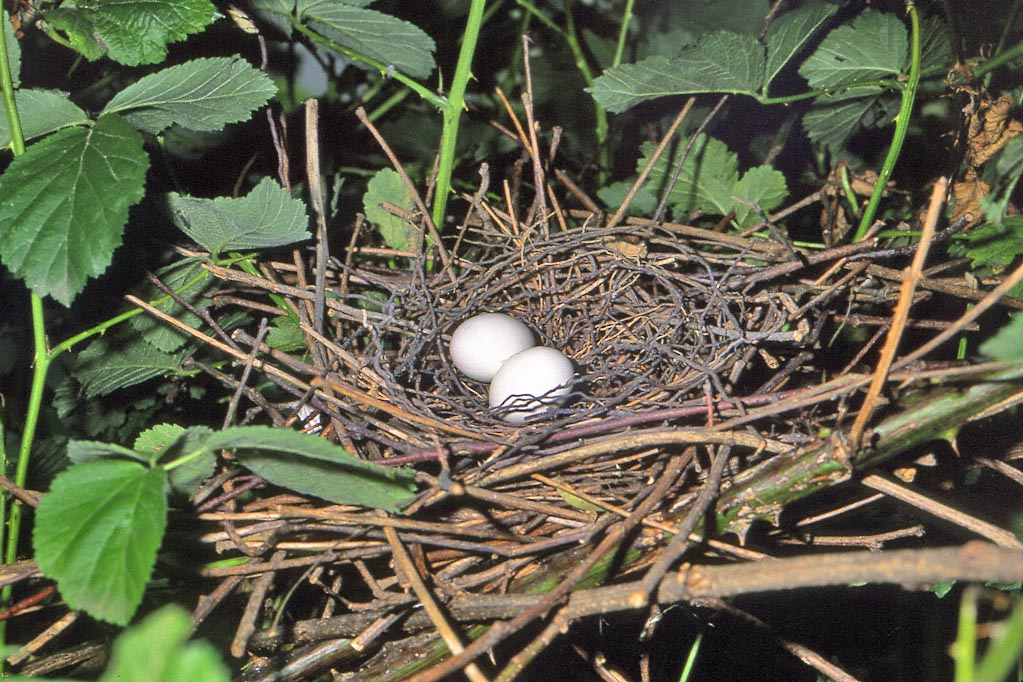
The nest, rather poorly made and weak, is put on a low horizontal branch. It contains only 2 eggs hatched by both parents © Gianfranco Colombo
Therefore, it is a subject who loves nesting in open country, in isolated locations and not frequented where it easily hides living its couple life in total isolation.
An explicit example of how strong its reluctance is and its strong fear towards us, is while nesting.
Unluckily and quite often, it’s sufficient to pass inadvertently close to its nest while brooding, to make it leave the nest definitely and without any reason.
It has even occurred in abandoned nests with just newborn babies, perhaps dictated by fear of having been discovered, together with the necessity to protect themselves, even at the cost of losing their children. Only the Eurasian jay (Garrulus glandarius) can do so much!
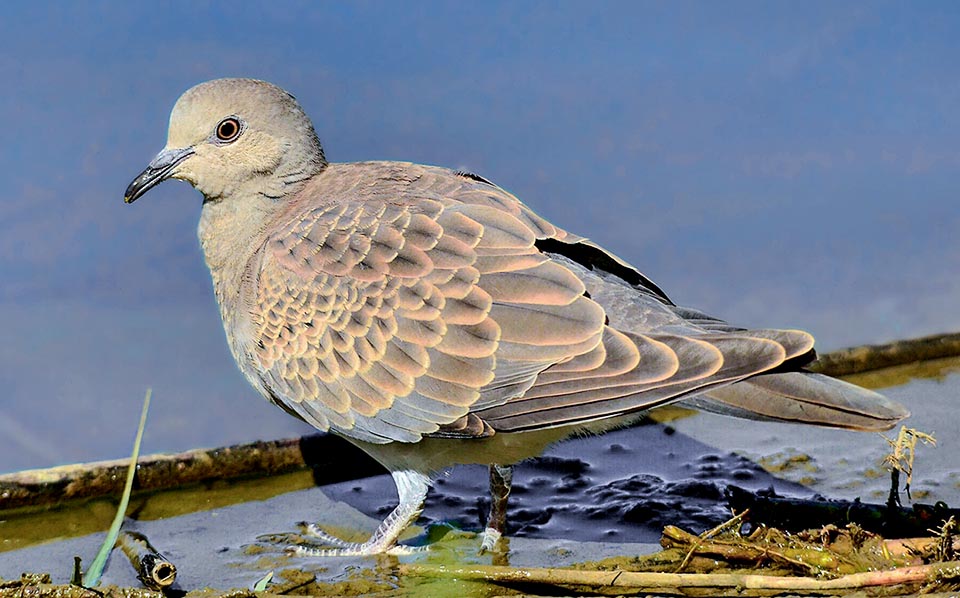
A young now grown up. For assuming the characteristic adults’ features it will have to wait for the moulting of the second year © Bruno Parisotto
The nest of the European turtle-dove is quite poorly done and is weak, as, on the other hand, all columbids do.
It is placed on a horizontal branch at a height of just a few metres and at times, when built on branches incipient water courses, to be lower than the level of their banks.
A few dry twigs to form an almost flat platform where to lay the two only very white eggs of the brood: the nest is so simple and reduced to make the eggs seen if looked from below.
The hatching is done by both partners for about two weeks and then they care for the newborns for two/three weeks more until fledging.
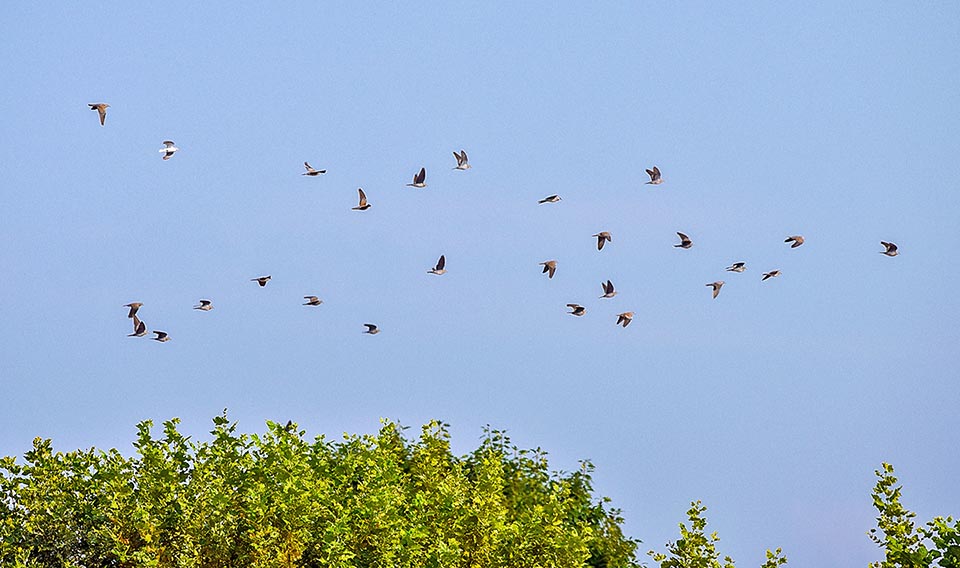
In late summer, with the first weather upheavals, flying flocks of Streptotelia turtur take form bound to sub-Saharan Africa © Gianfranco Colombo
Like all columbids also the turtle-doves feed their babies during the first days of their life with the pigeon’s goiter milk, a predigested liquid regurgitated directly into the goiter of the nestlings to then pass to a normal seed-based diet.
Usually they do two broods a year.
The song of the European Turtle-dove differs significantly from the singing of other members of the family, while keeping that constancy and complaint of the song typical of these birds. A continuous and vibrant “trrrr trrrr trrrr” with sometimes exasperating duration, emitted from invisible sites in the thick of the woods. However it is slightly kinder and less gloomy then the usual or the ubiquitous Rock dove nor even less from the triplet “cu cùuu cu” of the collared dove, so much that Vivaldi proposed its song again in the “Summer” of his Four Seasons.
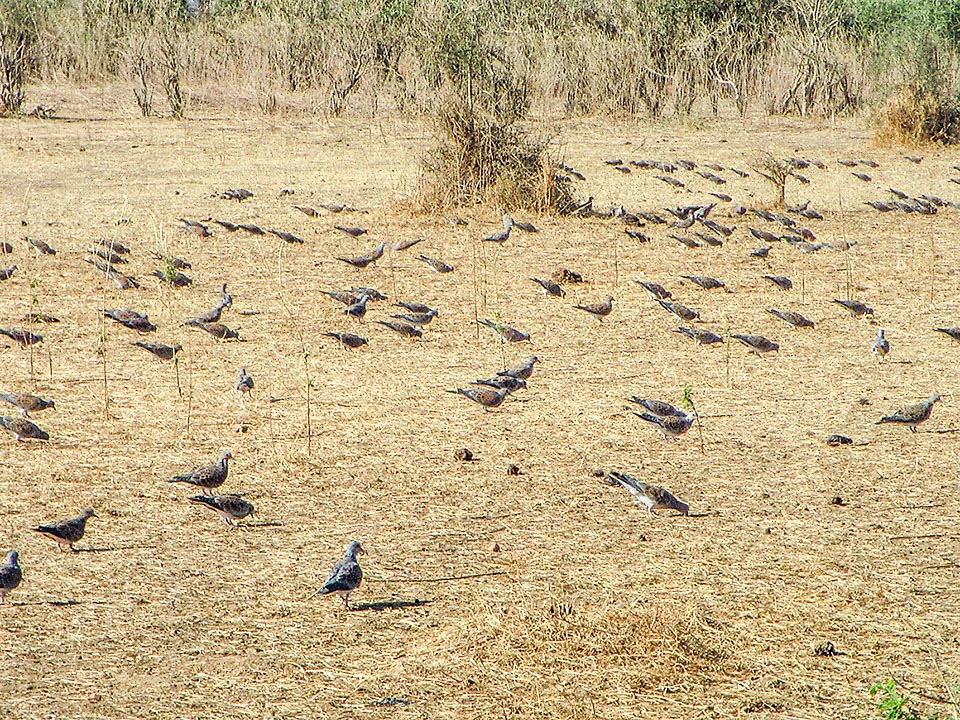
Here landed in Senegal while grazing in group without their usual shy and reserved behaviour they hold when staying in the nesting areas © Lucy Keith-Diagne
Streptopelia turtur, in decline in various areas, unfortunately nowadays appears as “VU Vulnerable” in the IUCN Red List of the endangered species.
In Hungary and in other more few European regions the species is protected and its hunting is forbidden, replacing it in the hunting calendars with the more invasive Collared dove presently become superior in number.
Synonyms
Columba turtur Linnaeus, 1758; Turtur turtur Boddaert, 1783.
→ To appreciate the biodiversity within COLUMBIFORMES please click here.
